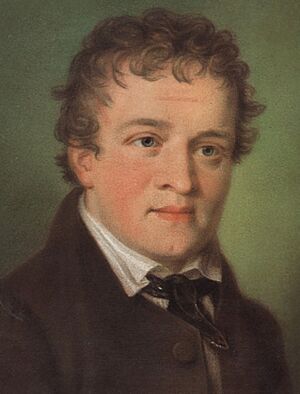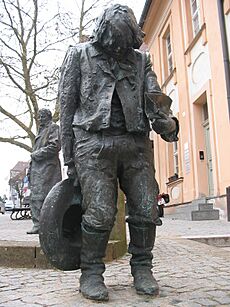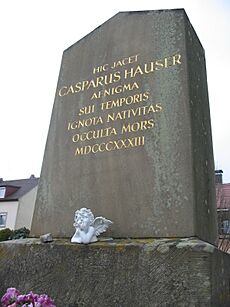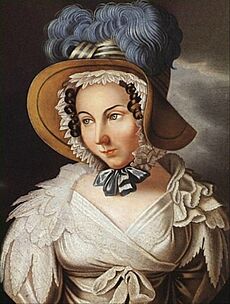Kaspar Hauser facts for kids
Quick facts for kids
Kaspar Hauser
|
|
|---|---|

Kaspar Hauser in 1830. Notice the scar on his forehead from a wound he got the year before.
|
|
| Born | 30 April 1812 |
| Died | 17 December 1833 (aged 21) Ansbach, Bavaria, German Confederation
|
| Cause of death | Stab wound |
| Known for | Claimed unusual upbringing and subsequent mysterious death |
Kaspar Hauser (born April 30, 1812 – died December 17, 1833) was a German teenager. He claimed he grew up completely alone in a dark room. His story, and his later death from a stab wound, caused a lot of discussion and mystery. Some people believed he was a hidden prince from a royal family. Others thought he was making up his story.
History
His First Appearance
On May 26, 1828, a teenage boy showed up in the city of Nuremberg, Germany. He carried a letter for Captain von Wessenig, a cavalry officer. The letter's heading said:
The place is unnamed
1828The letter's writer was unknown. It said the boy had been cared for since he was a baby in 1812. The writer taught him to read, write, and about Christianity. But the boy was never allowed to "take a single step out of my house." The letter asked the captain to take the boy in. It said the boy wanted to be a cavalryman, like his father.
Another short letter was inside. It seemed to be from the boy's mother to his caretaker. It said his name was Kaspar. It also said he was born on April 30, 1812. His father, a cavalryman, was dead. Later, people found that both letters were written by the same person. Some thought Kaspar Hauser himself wrote them.
A shoemaker took the boy to Captain von Wessenig's house. The boy only said, "I want to be a cavalryman, as my father was" and "Horse! Horse!" When asked more questions, he would cry or just say, "Don't know." He was taken to a police station. There, he wrote his name: Kaspar Hauser. He knew about money and could say some prayers. He could also read a little. But he answered few questions. His speaking skills seemed very limited. Since he couldn't explain himself, he was put in prison as a homeless person.
He stayed for two months in Luginsland Tower in Nuremberg Castle. A jailer named Andreas Hiltel looked after him. Kaspar was in good health and could walk well. He even climbed over 90 steps to his room. He looked healthy and was about 16 years old. But he seemed to have learning difficulties. However, Mayor Binder said the boy had a great memory. He also learned things quickly. Many curious people visited him, and he seemed happy about it. He only ate bread and drank water.
Kaspar's Story of Life in a Dark Room
At first, people thought Kaspar was a wild child from the forests. But during many talks with Mayor Binder, Kaspar told a different story. He later wrote it down in more detail. Kaspar said that for as long as he could remember, he lived alone in a dark cell. He described the cell as about two meters long, one meter wide, and one and a half meters high. It only had a straw bed and four wooden toys: two horses and a dog.
Kaspar claimed he found rye bread and water next to his bed every morning. Sometimes, the water tasted bitter. Drinking it made him sleep more deeply than usual. When he woke up on those days, his straw bed was changed. His hair and nails were also cut. Kaspar said the first person he ever met was a man. This man visited him just before he was set free. The man was careful not to show his face. This man taught him to write his name by guiding his hand. After learning to stand and walk, Kaspar was brought to Nuremberg. The stranger supposedly taught him to say, "I want to be a cavalryman, as my father was." But Kaspar said he didn't understand what the words meant.
This story made many people curious. Kaspar became famous around the world. Rumors started that he was from a royal family, possibly from Baden. But some people also said he was a fake.
Life in Nuremberg Continues
Paul Johann Anselm Ritter von Feuerbach, a high-ranking judge, started to look into Kaspar's case. The city of Nuremberg officially adopted Kaspar. Money was given for his care and education. He was placed with Friedrich Daumer, a schoolmaster. Daumer taught him many subjects. He found that Kaspar was good at drawing. Kaspar seemed to do well in this new home. Daumer also tried to treat him with special medicines and magnetic experiments. Feuerbach said that when Daumer held the north pole of a magnet near Kaspar, Kaspar felt a pull in his stomach. He said it felt like air was blowing from him.
The Forehead Wound
On October 17, 1829, Kaspar was found in Daumer's cellar. He was bleeding from a fresh cut on his forehead. He said that a hooded man attacked him while he was in the bathroom. The man also threatened him, saying, "You still have to die before you leave the city of Nuremberg." Kaspar said he recognized the man as the one who brought him to Nuremberg. His blood trail showed that Kaspar first ran to his room on the first floor. But instead of finding his caretakers, he went downstairs. He then climbed through a trap door into the cellar. Officials were worried. They called for police and moved him to the care of Johann Biberbach, a city official. This supposed attack made the rumors about Kaspar's royal background even stronger.
Some people who doubted Kaspar's story believed he cut himself with a razor. They thought he then took the razor back to his room before going to the cellar. He might have done this to get pity. He may have wanted to avoid being scolded for a recent argument with Daumer. Daumer had started to believe that Kaspar often lied.
The Pistol Accident
On April 3, 1830, a pistol fired in Kaspar's room at the Biberbachs' house. His escort quickly entered the room. They found him bleeding from a wound on the right side of his head. Kaspar soon recovered. He said he climbed on a chair to get some books. The chair fell. While trying to grab something, he accidentally pulled down a pistol hanging on the wall. This made it fire. Some people doubted if the pistol actually caused the small wound. Some writers connect this event to an earlier argument. Again, Kaspar had been accused of lying. Whatever happened, this event made the city officials make another decision about Kaspar. His good relationship with the Biberbach family had become bad. In May 1830, he was moved to the house of Baron von Tucher. The baron later complained about Kaspar's extreme pride and lies. Mrs. Biberbach said he was "horribly dishonest" and "good at pretending." She called him "full of pride and meanness."
Lord Stanhope's Involvement
A British nobleman, Lord Stanhope, became interested in Kaspar. He took care of him in late 1831. He spent a lot of money trying to find out where Kaspar came from. He paid for two trips to Hungary. He hoped it would help Kaspar remember things. Kaspar seemed to remember some Hungarian words. He had once said that a Hungarian Countess was his mother. But Kaspar did not recognize any buildings or places in Hungary. A Hungarian nobleman who met Kaspar later told Stanhope that he and his son laughed about the strange boy and his dramatic behavior. Stanhope later wrote that these failed attempts made him doubt Kaspar's story. In December 1831, he moved Kaspar to Ansbach. There, a schoolmaster named Johann Georg Meyer took care of him. In January 1832, Stanhope left Kaspar for good. Stanhope kept paying for Kaspar's living costs. But he never kept his promise to take him to England. After Kaspar's death, Stanhope wrote a book. In it, he shared all the evidence against Kaspar. He felt it was his "duty to openly admit that I had been tricked." Supporters of Kaspar thought Stanhope had other reasons for his actions. They even thought he was connected to the House of Baden. But historians usually see Stanhope as a kind person who wanted to find the truth.
Life and Death in Ansbach
Schoolmaster Meyer was a strict man. He did not like Kaspar's excuses and apparent lies. Their relationship was difficult. In late 1832, Kaspar started working as a copyist in a local law office. He still hoped Stanhope would take him to England. Kaspar was unhappy with his situation. It got worse when his supporter, Anselm von Feuerbach, died in May 1833. This was a great loss for Kaspar. Other writers say that Feuerbach had lost faith in Kaspar by the end of his life. However, there is no sign that Feuerbach, who was already very ill, let Kaspar know about this change of opinion.
On December 9, 1833, Kaspar had a serious argument with Meyer. Lord Stanhope was expected to visit Ansbach at Christmas. Meyer said he didn't know how he would face him.
The Fatal Stab Wound
Five days later, on December 14, 1833, Kaspar came home with a deep wound in his left chest. He said he was tricked into going to the Ansbach Court Garden. There, a stranger stabbed him and gave him a small bag. When policeman Herrlein searched the Court Garden, he found a small purple purse. It held a note written in mirror writing. The message in German said:
"Hauser will be able to tell you exactly how I look and where I am from. To save Hauser the trouble, I want to tell you myself where I come from. I come from the Bavarian border. On the river. I will even tell you the name: M. L. Ö."
Kaspar died from the wound on December 17, 1833.
Kaspar's story had some parts that didn't make sense. This made the Ansbach court suspect he had stabbed himself. They thought he then made up the story about being attacked. The note found in the purse had a spelling error and a grammar error. Both were typical mistakes for Kaspar. On his deathbed, he mumbled about "writing with pencil." Kaspar seemed eager for the purse to be found. But he didn't ask about what was inside it. Mrs. Meyer said the note itself was folded into a special triangle shape, just like Kaspar would fold his letters. Experts agreed that the wound could have been self-inflicted. Many writers believe he wounded himself to make people interested in his story again. He might have wanted to convince Stanhope to take him to England. But he might have hurt himself more deeply than he planned.
Burial
Kaspar Hauser was buried in the city cemetery in Ansbach. His headstone says in Latin, "Here lies Kaspar Hauser, riddle of his time. His birth was unknown, his death mysterious. 1833." A monument to him was later put up in the Court Garden. It says in Latin, "Here lies a mysterious one who was killed in a mysterious manner."
Psychological Views
Kaspar's different stories about his time in isolation had some contradictions. In 1970, a psychiatrist named Karl Leonhard said, "If he had lived since childhood in the conditions he described, he would not have developed beyond being an idiot. In fact, he would not have lived long. His story is so full of strange things that it's surprising it was ever believed."
Karl Leonhard believed that "Kaspar Hauser was, as others have said, a pathological swindler. Besides his dramatic behavior, he probably had a very stubborn personality. This allowed him to play his role so calmly. From many reports about his behavior, you can see both the dramatic and stubborn sides of his personality."
The "Hereditary Prince" Theory
Rumors
Old rumors, possibly from as early as 1829, said that Kaspar Hauser was the prince of Baden. This prince was born on September 29, 1812. History says this prince died on October 16, 1812. But the rumor claimed he was swapped with a dying baby. Then, 16 years later, he reappeared as Kaspar Hauser. If this were true, Kaspar's parents would have been Charles, Grand Duke of Baden and Stéphanie de Beauharnais. Stéphanie was a cousin by marriage and adopted daughter of Napoleon. Since Charles had no other sons who lived, his uncle, Louis, became the next ruler. Louis was later followed by his half-brother, Leopold. Leopold's mother, the Countess of Hochberg, was supposedly the one who planned the swap. The Countess was said to have dressed as a ghost, the "White Lady," to kidnap the prince. Her reason would have been to make sure her own sons could become rulers.
After Kaspar's death, some also claimed he was murdered. This was supposedly to hide his true identity as a prince. Kaspar was never married and had no children.
Evidence from the 1870s
In 1876, Otto Mittelstädt showed evidence against this theory. He used official papers about the prince's emergency baptism, autopsy, and burial. In his book Historical Mysteries, Andrew Lang summarized the findings: "It is true that the Grand Duchess was too ill to see her dead baby in 1812. But the baby's father, grandmother, and aunt, along with ten court doctors, nurses, and others, must have seen it after it died. It is too silly to think, without any proof, that they all took part in the White Lady's plan." Historian Fritz Trautz even wrote that, "The silly fairy tale, which still interests many people and is widely believed, was completely disproved in Otto Mittelstädt's book." Letters from the Grand Duke's mother, published in 1951, give detailed accounts of the child's birth, illness, and death. These letters would disprove the idea of swapped babies.
DNA Tests
In November 1996, a German magazine reported on a DNA test. Scientists tried to match a blood sample from underwear thought to be Kaspar Hauser's. This test was done in labs in Birmingham and Munich. Comparisons with family members of the princely family showed that the blood could not have come from the prince of Baden.
In 2002, another group of scientists tested hair and body cells. These came from locks of hair and clothes that also belonged to Kaspar Hauser. The scientists took six different DNA samples from these items. All of them were the same. However, they were very different from the blood sample tested in 1996. This made people question if the 1996 blood sample was truly Kaspar's. The new DNA samples were compared to DNA from Astrid von Medinger. She was a female descendant of Kaspar's supposed younger sister, Princess Josephine of Baden. Since this type of DNA (mitochondrial DNA) only passes through the female line, it should be very similar between siblings.
The DNA sequences were not exactly the same. But the difference was not big enough to rule out a family connection. The difference could be due to a small change (mutation) over generations. However, the similarity also doesn't fully prove the connection. The "Hauser samples" showed a DNA pattern common among the German population.
The House of Baden does not allow any medical tests on the remains of Stéphanie de Beauharnais or the child buried as her son. These remains are in the family tomb in Pforzheim.
See also
 In Spanish: Kaspar Hauser para niños
In Spanish: Kaspar Hauser para niños
- List of unsolved deaths
- Man in the Iron Mask







